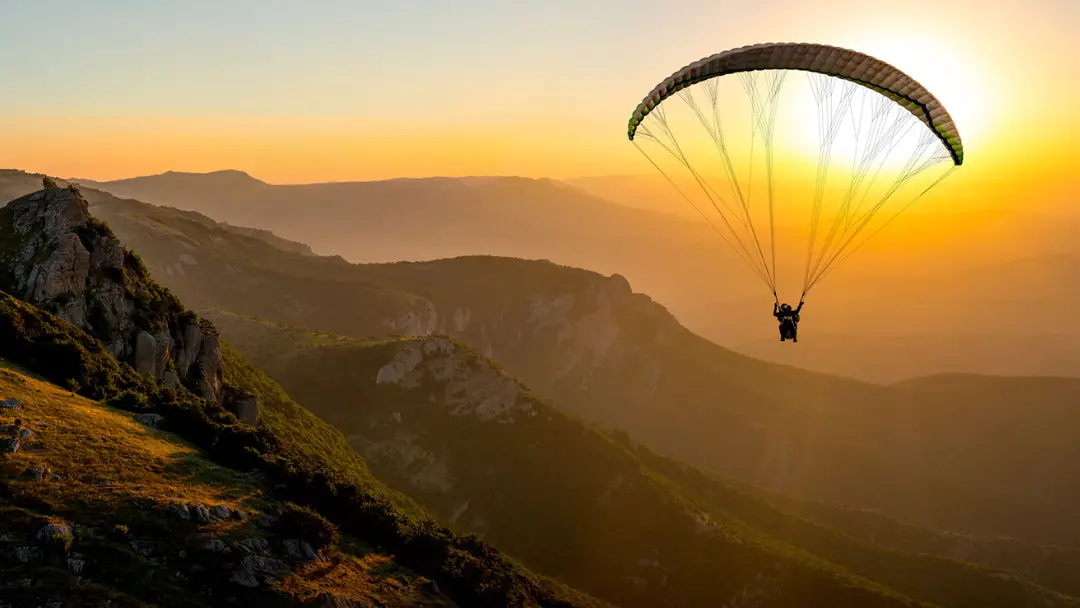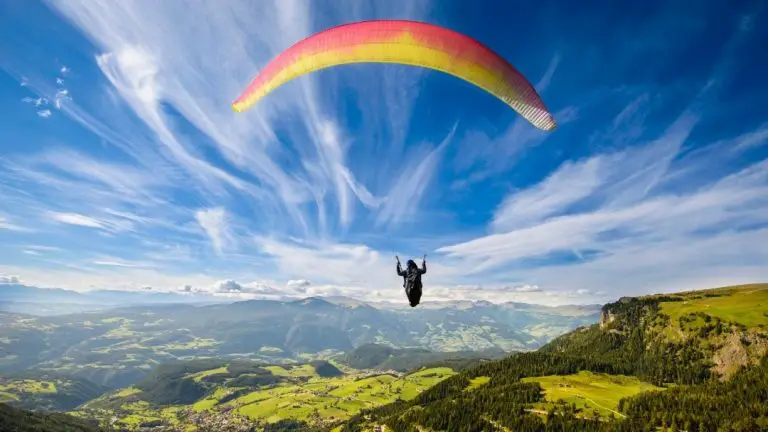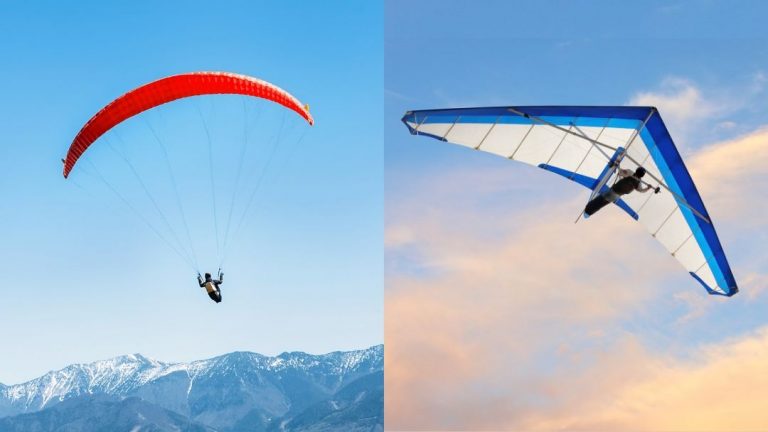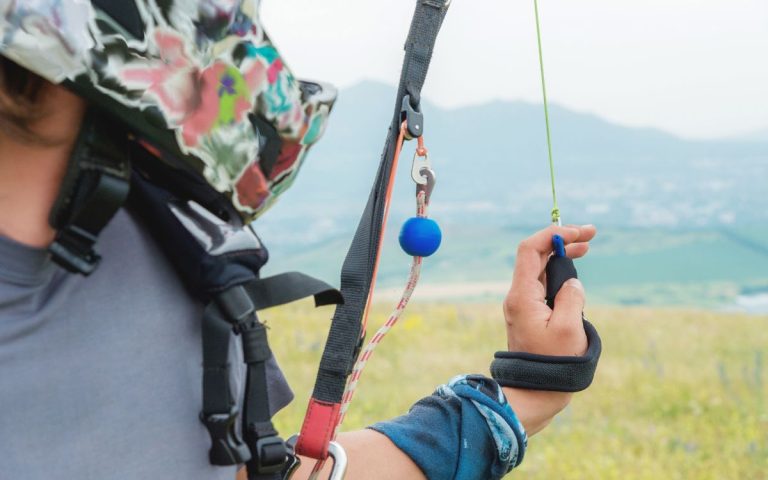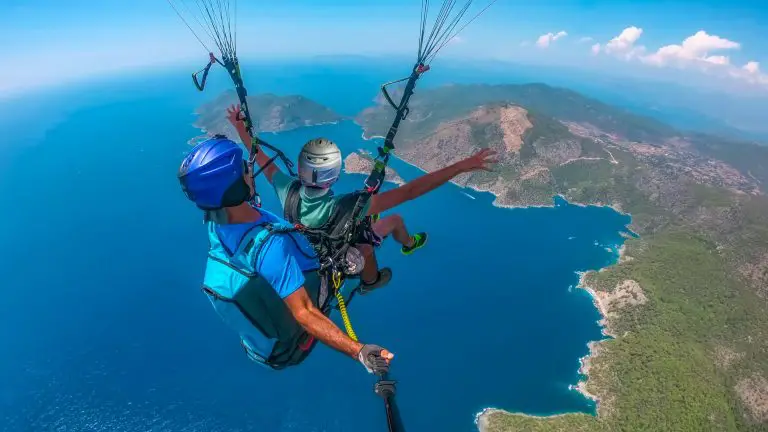Answers to Your Top Paraglider Questions
Paragliding is the ultimate sport for adventure lovers. You can fly freely, like a bird, while hanging from a piece of fabric that fits into a rucksack – it’s like magic! Except it isn’t, of course.
Interested in paragliding but not sure how it all works? Fear not, we’ve answered your top paraglider questions.
Paraglider questions about gear and the mechanics of paragliding
What is a paraglider?
A paraglider is an airfoil-shaped canopy, or wing, designed for free flight. Several strong, thin lines run from the wing to the carabiners attached to the pilot’s harness.
Airfoil? This is the characteristic shape of a wing of any form of aircraft, consisting of a more rounded top surface and a flatter bottom surface.
A paraglider looks quite similar to a parachute, but it is a steerable aircraft with a much higher glide ratio (meaning it will float to the ground far slower than a parachute does).
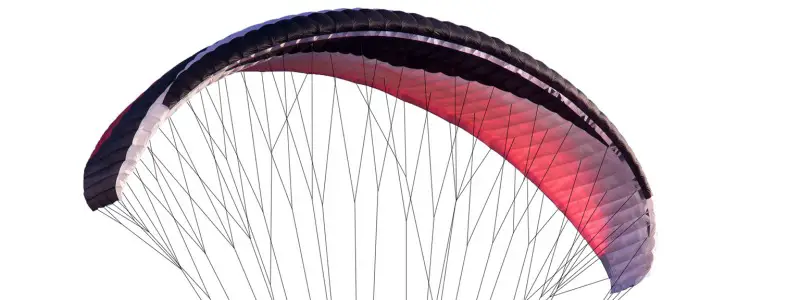
The paraglider generally consists of two layers of a special type of ripstop polyester or nylon connected by vertical ‘ribs.’ The front, or leading edge, of the paraglider, contains openings, known as cells, that allow air to enter and inflate the wing.
Because the back end of the wing, known as the trailing edge, is sealed shut, the paraglider has a ram-air design that will remain inflated as long as air moves over it.
How does a paraglider work?
To initiate flight, a paraglider needs airflow over its surface, a steep enough slope to launch from (unless being towed by an engine from flat ground), and the weight of the pilot and harness to keep pressure in the wing.
When ready to fly, you lay out the paraglider so that the leading edge is facing into wind. By pulling on the lines attached to the leading edge, air enters the cells and the wing will inflate, moving from the ground to flying above you in seconds.
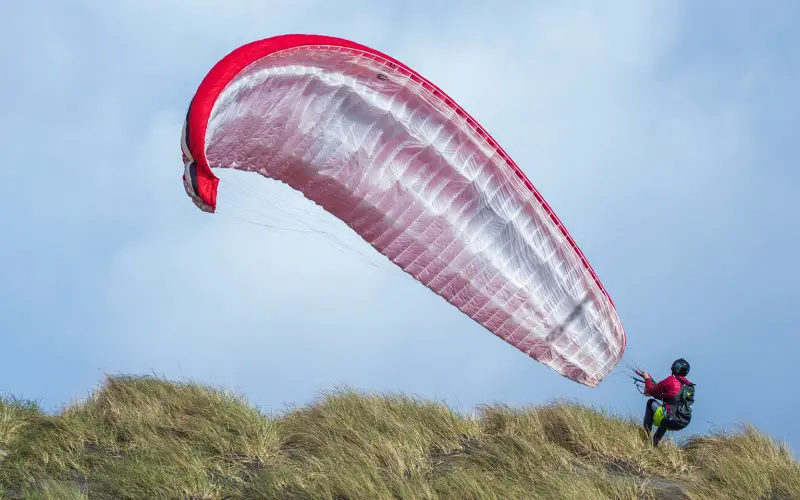
Once inflated, the paraglider will have its characteristic airfoil shape, and you will then merely need to run (in cases of no wind), walk (for a moderate breeze), or step off (rather breezy) the hill.
How does the airfoil shape enable flight?
Without getting too bogged down in aerodynamics, as air moves over the wing, some of the air molecules are forced over the top, curved surface of the wing (resulting in an area of lower pressure), while some air molecules are forced below the flatter surface of the wing (resulting in an area of higher pressure). This imbalance between high and low pressure results in a lift force.
Without an engine, the lift force generated by the airfoil will not be enough to overcome the force of gravity (from the weight of the pilot, harness, and wing) on its own, but it is enough to allow you to slowly float to the ground rather than free fall. This gives you enough time to find sources of lifting air to help overcome gravity and gain altitude.
How does a paraglider turn?
A paraglider is relatively simple to turn and control (as long as the weather conditions are right, of course) using a combination of weight shift and pulling the relevant brake/control line.
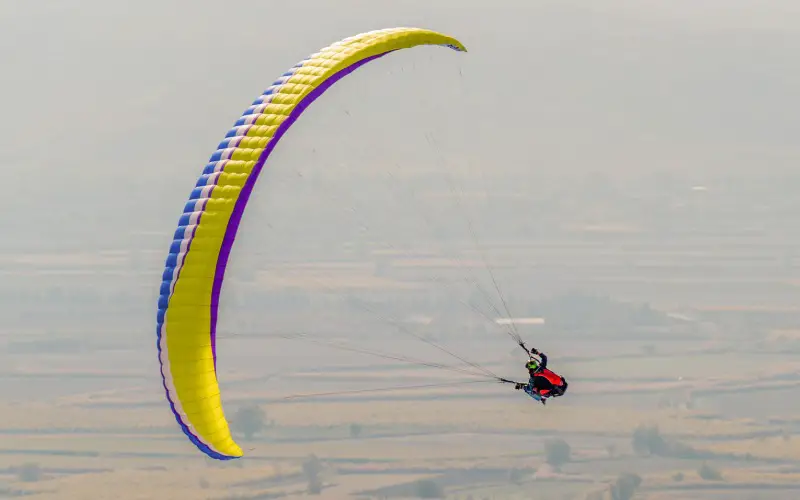
Weight shift
Paraglider pilots use their weight to control the wing. By leaning your weight over to the right, you cause the paraglider to tilt over to the right, inducing a slow turn.
Generally, a turn is initiated by weight shift before pulling on the brake line. In smooth soaring conditions, weight shift alone is enough to turn the paraglider.
Brakes
The brake lines are connected to various points on the trailing edge. The lines from the left half of the wing attach to a single brake line and handle that is controlled with your left hand, and vice versa.
Essentially, the brake lines perform the same function as both the steering wheel and brakes of a car, so they are also known as the control lines.
By pulling on the left brake, the paraglider turns left; pull on the right brake and the paraglider will turn right. By pulling on both brakes at the same time, you slow the paraglider down.
Why does pulling on these strings turn the paraglider?
By pulling on the left brake, you pull one side of the trailing edge of the wing down. This increases the drag on this side of the paraglider, slowing it down slightly. The right-hand side of the wing then flies faster than the left, and the paraglider will turn left.
How does a paraglider stay in the air?
The ram-air, airfoil-shaped design of the paraglider ensures it will remain pressurized as long as air is moving over it, but this isn’t enough to overcome the force of gravity. For a prolonged flight and to gain altitude, the paraglider needs to fly through rising air.
Paragliders use two main types of rising air: ridge lift and thermals.
Wave lift is a third form of rising air that is occasionally flown by paragliders. Wave is generally formed on the lee side of a mountain in high winds. Flying a paraglider in wave lift is very risky due to the potential for extreme height gain, turbulent air, and strong wind.
Ridge lift
Ridge lift occurs when wind meets a steeply sloping obstacle, such as a mountain or hill. The wind is forced up and over the top of the mountain, resulting in a band of rising air that paragliders can soar.
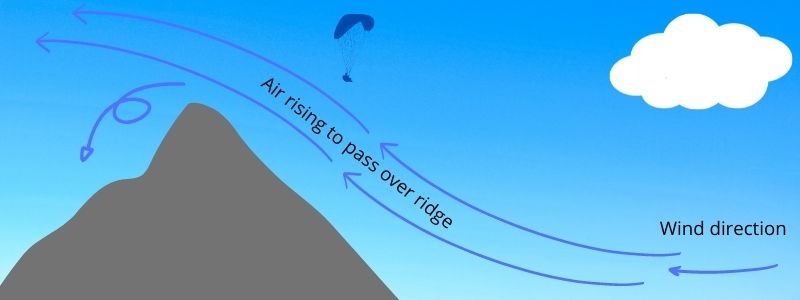
The paraglider can fly, using this ridge lift, for as long as the weather conditions allow (enough of a breeze, but not too much, and from the right direction). However, the height of the mountain or hill limits the amount of altitude you can gain from this type of lift.
Thermals
A thermal is a column of rising air caused by uneven heating of the ground. When you see birds of prey circling, getting higher and higher with each circuit, they are using thermal lift to gain altitude.
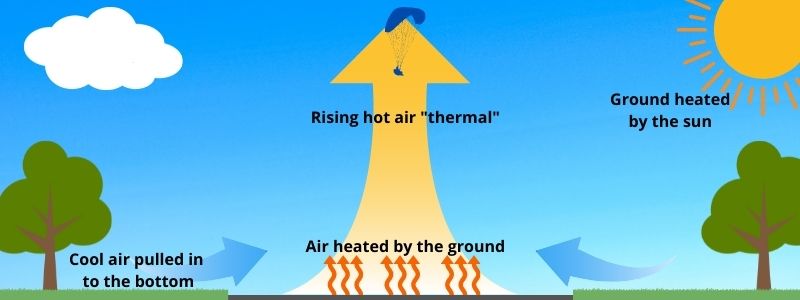
Paragliders use thermals in just the same way (although much less efficiently). Finding thermals while paragliding can be tricky, but once established in a good thermal you can gain incredible altitude and fly up to cloud base.
How does a thermal form?
On a warm sunny day, a brown ploughed field will get hotter than surrounding bodies of water, forest, or green fields. The atmosphere immediately above the ploughed field will then also get warmer.
The warm air is less dense than the surrounding cooler air, so it rises. As it does so, cooler air near the ground is pulled in to replace the rising air, and this air then warms up and rises too, continuing the cycle.
How does a paraglider land?
When you see a paraglider soaring way up high near the clouds, you may wonder – how on earth do you land that thing? Thankfully, as long as you are flying in appropriate conditions, landing is pretty straightforward.
Paragliders only go up while they are in lifting air (when in a thermal or in ridge lift), otherwise, they are going down, albeit very slowly. So, landing a paraglider largely has to do with making sure you put yourself in a good position when you finally approach the ground.
Landing a paraglider involves the following steps:
- First, you must decide where you want to land.
This decision is usually made before you start flying, or well before you intend to land.
At established paragliding sites there is generally a specified landing field. When flying cross country, you will need to identify a safe landing field yourself.
Landing fields must be large, free of obstacles and turbulent air, relatively flat, and – preferably – within reach of a suitable road/exit.
- Next, leave any sources of lift and start making your way to the landing field.
This means turning into the wind, away from the mountain or hill (and preferably avoiding any thermal triggers on your way). - Set up your landing approach.
Hopefully, you will reach the landing field with plenty of height and you’ll need to burn off the excess by making a controlled circuit of the field or flying back and forth in a figure-of-eight motion just upwind of your landing spot. - Make your final glide to the landing spot.
By now, you will have lost enough height. Turn straight into the wind and push forward in your harness, getting your legs down and ready for landing. - Flare for a landing.
Just before touchdown, apply steady, deep brakes to effectively stall the paraglider, and run off any excess speed as needed.
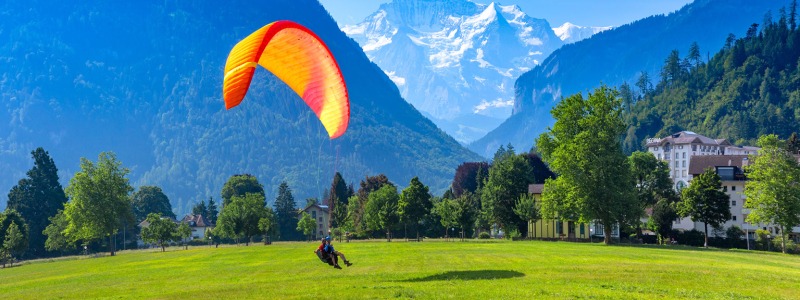
Although landing a paraglider is quite simple in theory, it is one of the most dangerous parts of the flight (along with launching) because you are so close to the ground.
The air at ground level may be turbulent, so it is very important to fly at full speed until just before touchdown. This helps ensure the paraglider remains fully pressurized, minimizing the chance of a collapse.
Paragliders are designed to remain as pressurized and stable as possible, but collapses can occur in turbulent air or from incorrect pilot input. Generally, the paraglider will recover from most collapses within a moment or two, but the risk of an accident increases when a collapse occurs very close to the ground.
Paraglider questions about free flying
How long can a paraglider stay in the air?
It depends. A paraglider can be in the air for as short a time as a few seconds (if paragliding off of a small hill in very light winds), or for several hours (if ridge soaring in a steady breeze or if you are flying from thermal to thermal).
Beginner paragliding pilots who have just finished their training will be stoked to stay in the air for around 30 minutes, while the more experienced pilots think nothing of a 3-hour cross country flight. On average, a decent flying day could involve a couple of flights, each lasting about an hour or two.
In 2019, a team of Brazilian pilots flew for over 11 hours to break the paragliding world distance record.
How far can a paraglider fly?
Paragliders have a glide ratio of about 9:1, which means that (in calm air) the paraglider will move forward 9 units for every 1 unit of altitude lost. So, even in no wind, if you take off from a height of 1000 ft above sea level, you could theoretically land about 9000 ft away.
It is a different ball game when you’re thermal flying, however. Cross-country pilots can cover vast distances by flying from one thermal to another, topping up their altitude as they go.
Fairly experienced paraglider pilots can cover over 60 miles on a good thermic day.
The current record for paragliding in the United States is 315 miles, while a team of Brazilian pilots set the global record of 365 miles in 2019.
Can you paraglide with no wind?
Yes, you absolutely can paraglide with no wind, you just have to be prepared to run like hell to launch your paraglider. A breeze makes the take-off process a little easier, but you can simulate a breeze just by running during take off.
This may seem counterintuitive, but as long as the paraglider is moving through the air, it will remain inflated.
Flying in very light or no wind is common in mountainous areas, where you launch the paraglider from a high altitude and glide down slowly, just enjoying the view or possibly picking up a thermal on the way down.
Without a decent headwind during your landing approach, your approach will be fast, but you merely need to run this off during landing.
How high can paragliders go?
When thermal flying, paragliders can fly as high as the top of a thermal (known as cloud base), which varies depending on the weather conditions on the day.
Paragliders often fly higher than 5000 ft above the ground, and very experienced pilots reach more than 20,000 ft (3.8 miles).
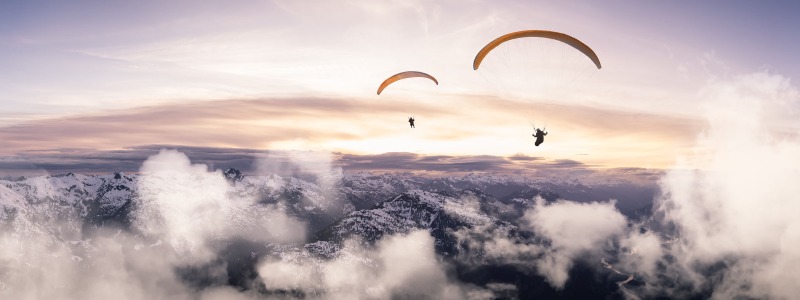
In 2021, Antoine Girard broke the paragliding altitude record (breaking his own record from 5 years previously) in Pakistan – he reached an incredible altitude of 27,582 ft (5.22 miles). Luckily he had supplemental oxygen on board!
When flying in ridge lift, the paraglider is limited to the height of the lift band surrounding the ridge. A rule of thumb for this type of paragliding is that you can fly up to double the height of the ridge, if conditions are ideal.
Paraglider questions about safety
Paraglider questions around safety could understandably be at the top of your mind. Paragliding is an incredible sport, but it is also a risky one.
Do paragliders have parachutes?
Yes, most paragliding pilots fly with a reserve parachute. The reserve parachute serves as a safety measure if everything goes wrong and your paraglider fails.
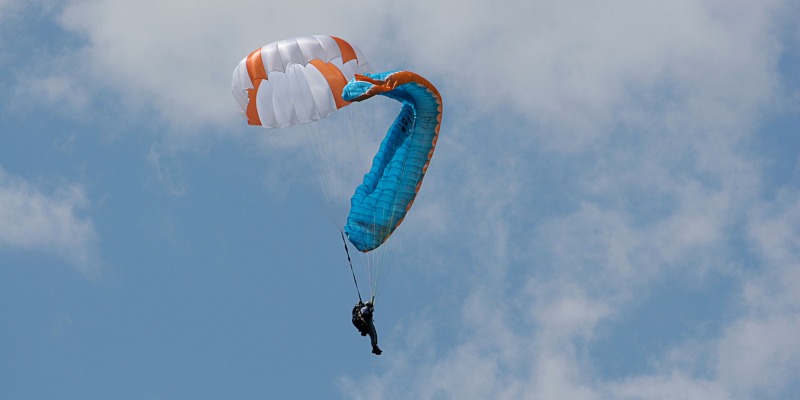
The reserve parachute is generally packed away within the harness, with a deployment handle within reach at all times.
Do you need special training to paraglide?
Absolutely. You should undertake professional training with a reputable school recognized by the aviation authority in your country. In the United States, this is the US Hang Gliding and Paragliding Association; in the United Kingdom, it is the British Hang Gliding and Paragliding Association.

